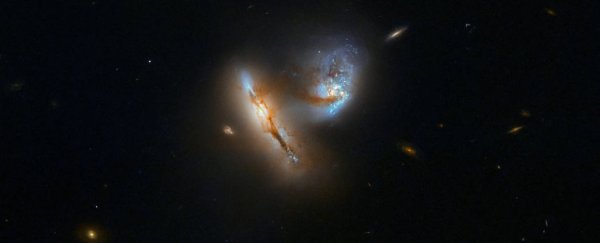The illustrious Hubble Space Telescope has captured two passing galaxies making contact for the first time. Known as UGC 2369, the featured duo is fated to one day merge and become a single galaxy. But for now, the two galaxies are just getting to know each other.
In the image below, the pair can be seen swirling around one another, as their mutual attraction (read: gravity) pulls them closer together. According to the European Space Agency (ESA), all that currently connects the two galaxies is a "tenuous bridge of gas, dust and stars", almost as if they were holding hands.
This is UGC 2369, seen by NASA/ESA @HUBBLE_space. It's actually two galaxies interacting, being pulled closer together by their gravitational attraction, in a similar process that will see our galaxy, the Milky Way, collide with the Andromeda galaxy. See https://t.co/ZzsB04tVNr pic.twitter.com/bDAtydgWSl
— European Space Agency (@esa) August 5, 2019
Galaxies are extroverts at heart - most belong to galactic groups or clusters. In such close quarters, interaction between two or more members is not uncommon. Even when a collision is somehow avoided, the intense gravitational pull can still bend a galaxy out of shape.
In many ways, this is what makes galactic interactions so stunning to observe. For instance, galaxy fly-bys - where no contact is made - can create permanent warps, bars and tidal tails that extend way out from the galaxy's center, morphing it into unusual shapes and inducing new bursts of star formation.
Mergers, on the other hand, are a lot more destructive, and that's especially true when the galaxies are of roughly equal size. These bigger events are less common than minor mergers, but it thought that our own galaxy has one coming in its future.
Right now, the Milky Way we live in is busy shredding and absorbing two nearby dwarf galaxies, known as Sagittarius and Canis Major. One day, however, it is our galaxy that could become the meal.
Astronomers are quite certain that the Milky Way and the Andromeda galaxies will collide at some point billions of years in the future - becoming 'Milkomeda', if you will. Exactly when that might be and how it will play out is still up for debate.
Even though the UGC 2369 merger looks fresh, this galactic duo is actually considered to be in a relatively advanced stage. Training Hubble's eye on interactions like this might therefore give us a glimpse of our own galaxy's destiny.
